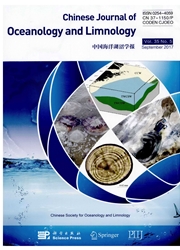

 中文摘要:
中文摘要:
我们把第三级的卵膜(TGM ) 与 2-day-old 和墨鱼 Sepiella maindroni de Rochebrune 的 25-day-old 卵分开了,并且揭示了它的超微结构,物理(溶解度,障碍性质) 并且生物化学(组织学,组织化学,营养的部件,细菌抑制) 特征。结果证明 TGM 不能与自然海水被溶解,酒精,醚或盐酸酸(HCl ) ,但是它能与 2-chloroethanol, diethylamine,和钠氢氧化物(NaOH ) 被溶解。黑 TGM 在堵住离开泥微粒是更有效的,微生物(小球藻 vulgaris, Vibrio alginolyticus ) 并且比白 TGM 轻。黑、白的 TGM 的弹性分别地是 1.8 N 和 1.5 N。在黑 TGM 有一些墨水微粒和条形的细菌。营养的部件在黑、白的 TGM 之间是不同的:类脂化合物内容更低,蛋白质内容在黑 TGM 是更高的。TGM 能也禁止 Vibrio alginolyticus 的生长。
 英文摘要:
英文摘要:
We separated tertiary egg membrane (TGM) from 2- and 25-day-old eggs of cuttlefish Sepiella maindroni de Rochebrune, and revealed its ultrastructure, physical (solubility, barrier property) and biochemical (histology, histochemistry, nutritional components, bacteriostasis) characteristics. The results show that TGM could not be dissolved with natural seawater, alcohol, ether or hydrochloric acid (HC1), but it could be dissolved with 2-chloroethanol, diethylamine, and sodium hydroxide (NaOH). The black TGM was more effective in blocking off mud particulates, microorganisms (Chlorella vulgaris, Vibrio alginolyticus) and lighter than the white TGM. The elasticity of black and white TGMs was 1.8 N and 1.5 N, respectively. There were some ink particulates and rod-shaped bacteria in the black TGM. The nutritional components were different between black and white TGMs: Lipid content was lower and protein content was higher in the black TGM. TGM could also inhibit the growth of Vibrio alginolyticus.
 同期刊论文项目
同期刊论文项目
 同项目期刊论文
同项目期刊论文
 期刊信息
期刊信息
